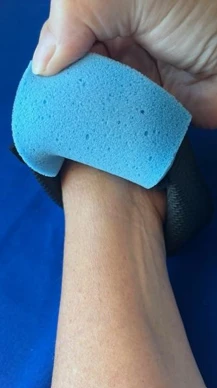What a Pain! Injury to the Superficial Branch of the Radial Nerve
May 4, 2024
4 min. read

As a physical therapist (PT) or occupational therapist (OT), how can you help a patient who is experiencing severe pain on the dorsal aspect of their hand? Radial nerve injury, particularly to the superficial branch, can result in significant pain and discomfort. Recovery from this painful condition may take weeks or months, and some patients even experience lifelong symptoms.1
Clinicians might encounter patients who have sought out pain relief from a variety of healthcare providers, with unsuccessful results. In this article, well take a look at tools you can use to help patients manage this condition.
Why Does Radial Nerve Injury Cause Dorsal Hand Pain?
The superficial branch of the radial nerve (SBRN) supplies sensation to the radial dorsal skin of the forearm and hand (see Figure 1). When this nerve is injured, it can lead to persistent neuropathic pain in these areas, resulting in discomfort and functional limitations. This pain occurs because the nerve fibers, which are responsible for transmitting sensory information, become damaged or irritated. Understanding the underlying causes of these injuries can help in effective management and treatment.

Figure 1: Typical Area of Pain Involvement Due to Superficial Branch of the Radial Nerve Injury
Injuries to the superficial branch of the radial nerve can occur with:
Trauma: Direct impact or blunt force trauma can damage the radial nerve, leading to neuropathic pain.
Surgery to the radial side of the hand: Surgical procedures in the area can inadvertently harm the nerve, resulting in chronic pain.
Hand osteoarthritis: Degeneration of the joints can cause compression and irritation of the radial nerve.
Wearing a bracelet that is too tight: Prolonged pressure from tight accessories can compress the nerve, causing pain.
Internal compression from brachioradialis or a lipoma: Muscle overuse or growth of benign tumors can exert pressure on the radial nerve.
Intravenous (IV) catheter: Improper placement of IV catheters can damage the nerve.
Strategies for Managing Pain from Radial Nerve Injury
1. Using a TENS Unit
Transcutaneous electrical nerve stimulation (TENS) has been shown to produce analgesic effects through neurobiological mechanisms affecting peripheral nervous systems.2 TENS, set to comfortable, perceptible tingling, is one tool clinicians can use to help patients manage this troublesome pain.
In my experience, using the Burst setting and placing the electrodes proximal and distal to the painful area (see Figure 2) has been effective in decreasing pain to the irritated superficial branch of the radial nerve. Patients should wear the TENS unit 2-4 times a day, especially before bedtime to help with sleeping, but optimal frequency and duration of the TENS application varies in research studies.

Figure 2: Recommended TENS Electrode Placement
2. Adding Neoprene Padding
Another coping mechanism for individuals with pain at the superficial branch of the radial nerve is adding neoprene padding to the painful area (see Figure 3). This can help protect the area from accidental trauma and from bumping it during daily activities.

Figure 3: Neoprene Padding
Patients can also use a neoprene thumb orthosis with foam (see Figure 4) or silicone padding over the specific area with the nerve irritation.

Figure 4: Neoprene Thumb Orthosis with Foam
These strategies can help mitigate the symptoms of radial nerve injury by providing pain relief and protecting the affected area from further irritation. By reducing pain and discomfort, patients can engage more effectively in daily activities and therapeutic exercises.
Monitor and Adjust Treatment Plans
In all cases, clinicians should monitor the patient and refer them to a hand surgeon if improvement doesn't occur with these conservative measures. In some cases, surgeons can use repeated local anesthetic blocks, but in other cases this condition can result in a painful neuroma that requires surgical intervention. If radial nerve injury persists despite these measures, further evaluation and treatment options should be considered to prevent long-term complications.
Below, watch Jeanine Beasley explain how to perform TENS treatment for SBRN pain in this brief clip from her MedBridge course "Orthotic Management for Peripheral Nerve Injuries of the Upper Extremity."






